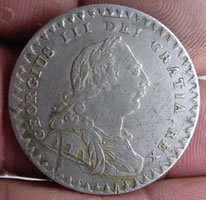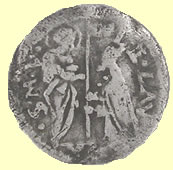- News
- Finds
- History
- Holidays
- Arch'gy
- Exporting
- Treasure
- Awards
- Tips
- Comps
- Forum
- Club info
- Contact
 |
Metal detecting holidays in England with the Worlds most successful metal detecting club Twinned with Midwest Historical Research Society USA |
|
Old
News Nov 2006 to March 2007
|
|
7th March 2007 Indenfiying coins - More exports approved A list of the latest approved export licenses that arrived this morning has been posted on the members forum.
|
||||||||||||||
|
6th March 2007 Nice silver day We got out for a few hours yesterday as we needed a fix before the main hunts start this Saturday. We detected a new site near some old Tudor houses and it produced the extremes of silver coin finds, Medieval hammered silver half penny and a huge George III milled silver crown. This area has never been detected and shows great potential as a large date range of copper coins was also found. I finished on two milled silver and Basildon Mark got the two hammered silver.
1443 - 5 Henry VI hammered silver halfpenny, Pellet - Leaf issue Type 2e, extra pellets under DON and TAS in CIVITAS LONDON 0.47g, 12.64mm, 1819 George III milled silver crown ( 60 pence) 28.04g, 37.96mm
1787 George III milled silver shilling - 16thC Elizabeth 1st hammered silver half groat |
||||||||||||||
|
5th March 2006 Coroner's letter
|
||||||||||||||
|
4th March 2007 Hammered gold Stunning early hammered gold find by Les UK who is with Mass Bruce detecting some new sites they have just got south of the river. Bruce also found a nice 2nd C Roman trumpet brooch and what looks to be an 8thC hanger, great finds. Both the boys are coming back here on Monday so that Les can try and do the double on the new land LOL.
Edward III Fourth coinage 1351 - 1361, E in shield Qtr Noble - EDWAR (D G) R (EX) ANGL Z FRANC (HYB) STD TYPE
C pellet below shield, reverse legend ends in AN |
||||||||||||||
|
3rd March 2007 Celtic Coin Index. -Web site link
Left picture shows a rarer coin with the full legend of Addedomaros at the bottom (CCI 05.0283) with most of the horse missing and the one on the right is a centrally stuck example with full horse and no legend (CCI 05.0196) Dr Philip de Jersey who runs the National Celtic Coin Index is a real Iron age expert and will record any coins you find and issue you with a unique CCI number for you coin. You will get an exact ID telling you the rarity, type, numbers on record. It is very important to record every Celtic coin you find to increase our knowledge of Celtic history and understand the spread patterns of tribes. Philip is currently working on a new publication on Celtic hoards found in Britain which will include those we have found here. If you have any Celtic coins yet to be recorded then drop Philip an e-mail with pictures, weight and diameter and you will be issued with your own CCI number and they will be added to the National data base. philip.dejersey@archaeology.oxford.ac.uk Examples below are coins we found with Philips comments
'another cracking little coin. It is the biga type as you say, still quite rare: we have just over 20 of the quarter recorded, it looks as though it's one of the later strikings of this type, because of the simplified CAMVL inscription on the obverse. The earliest examples have each letter very clearly defined, but they soon merge into what looks almost like a zigzag on some coins. Saying it's a 'late
striking' is all relative of course: it's possible that the biga type
was struck over a very short period, perhaps even just months and certainly
unlikely to be more than say five years or so, sometime around 8 - 13
AD I would estimate. It'll be CCI 05.0688
"it's
an early (perhaps c. 50-40 BC) quarter stater, possibly produced in
Essex. This
particular type is unpublished in any major catalogue, |
||||||||||||||
|
1st March 2007 Got out for a few hours
King John 1199 AD hammered silver penny Class 5b(ii) Possible Moneyer SIMON Chichester (Cices) |
||||||||||||||
|
28th Feb 2007 New GPR kit
The aim of this mapping is to further understand the archaeology of this very important Bronze age Celtic area and eventually to sponsor a professional dig by one of the registered field archeology groups. The landowners support us 100% and have already given us full permission for any excavation we sponsor. We intend to start the mapping this summer and the results will be posted on the site. See GPR link for an overview of what GPR is and the results you can achieve. |
||||||||||||||
|
26th Feb 2007 Another treasure and disclaimed items - Updated hoard and treasure page
We currently have two recent treasure items that have been disclaimed by the British Museum i.e. no museum wishes to acquire the item and they are also are being returned to the finders. The treasure act is the fairest system in the world and ensures that important historical items they wish to acquire end up with a museum or the find is returned to you.
Recent Disclaimed items - Roman silver scraper and Medieval gold ring |
||||||||||||||
|
25th Feb 2007 Added a new early history of Colchester page This new page covers the early years of Colchester and the Celtic kings in more detail
45 BC Addedomaros Celtic gold full staters The last Trinovantian king was called Addedomaros. His remains are possibly buried in the Lexden Tumulus close to Gosbecks Colchester |
||||||||||||||
|
25th Feb 2007 Latest coins back from the straighteners - interesting button
1594 Elizabeth 1st hammered silver penny
King John 1204/5 AD hammered silver voided short cross penny - Class 5b -6a Inital cross pommee - figure 10 E
1307 Edward II hammered silver groat EDWARDVS DI GRA REX ANGLE CIVIAS LONDON 2.17g, 22.72mm
|
||||||||||||||
|
25th Feb 2007 - Last minute space at the new house
|
||||||||||||||
|
22nd Feb 2007 More info on the Roman gold I sent our Roman expert pictures of the two gold Tiberius 14 to 37 AD gold Aureus for comparison and asked why the subtle differences in the dies. Here is his reply, fascinating stuff. 'First off, that a 1st
century aureus tested at .970 fine should not be particularly surprising.
Historically, in the pre-Roman era, precious metal coins tended to be
made of as pure a metal as the technology of the time allowed. Rome,
of course, during the Imperial period went through level after level
of debasing its circulating coins. Gold, however, didn't "circulate"
in the same manner in which silver and copper coins did. Although it
played an important part in the monetary system, gold was used more
as a store of value than in everyday transactions. Simply stated, an
aureus was too much money to be useful - rather like a $1000 bill -
few vendors would normally be able to make change for one. The "Tribute Penny in Gold" - as this type is often referred to - is probably the most common surviving 1st century Roman gold coin. This is because Tiberius was a reluctant and uninvolved emperor and distanced himself from the day-to-day concerns of government to the best of his abilities. Among the other things he never allowed himself to worry about was the design of coinage - and his types remained unchanged throughout his long reign. In the first of your two specimens, you have a good example of Tiberius' earlier portraiture. In the beginning of his reign he had himself portrayed to look as much like the dead Augustus as possible, as if to say: "Everything's alright, nothing has really changed." and conflate his official image with Augustus'. As his long, 23 year reign progressed, the portraiture on these frozen types slowly came to resemble him more, as the hawk-nosed portrait on the second specimen shows. The RIC recognizes 3 or 4 different "types" based, mainly, on differences in the the turnings on the legs of the throne on the reverse. That there are significant differences, however, in coins coming from hand-engraved dies over more than 2 decades is not surprising. I don't know if there has been any significant study of chronology of this type based on die-identity and/or style - I suspect there may have been, but I wouldn't know where to look for it. I believe these were only issued from the mint at Lugdunum (Lyons) which was the only mint for precious metal issues at this time.' Mark Lehman |
||||||||||||||
|
22nd Feb 2007 Gold finds ID A couple of guys just sent me mails of gold finds they have made for ID, further info and recording. The Angel was found on a site up North in the entrance to a field that sucked really bad LOL. I have sent the other one off to our Roman expert but it is clearly a Tiberius 14 to 37 AD gold Aureus like the one we found two years ago which was probably the finest of it's type found in Britain. There is little to choose between the two, condition is amazing.
Mic Tracy's
Tiberius 14 to 37 AD gold Aureus - 'Tested as ancient gold 97% pure'
Tiberius 14 to 37 AD gold Aureus - sent to our Roman expert for more info
Difficult to ID without the coin in my hand but it appears to be. E and Rose by mast marking it possibly a Edward IV 1471 -1483, mint mark appears to be Sun and Rose and I can see partial legend of EDWARD DI GRA REX ANGL Z FRANC
|
||||||||||||||
|
20th Feb 2007 Paper work and posting - password fault The next hunts do not start until the 10th March and a lot of time will probably be spent on the new sites we are starting to hot spot. The unknown is always great fun. This break will give me chance to do more work on an Archeology report I am compiling on one of our major sites which will be published later in the year. We are fortunate that we always photograph all finds made here so we have a record to refer to when a finds pattern starts to develop on any site. We have around 30.000 photos logged so far. Recording all your finds is the most important aspect to detecting and will eventually go into the DCMS on line database. http://www.finds.org.uk/. This data base is brilliant for trying to ID a find you have made. There is an on line form you can use 'e-mail finds recording template' prepared by Corinne Mills & Phil Dunning that can be sent your local FLO to record your item. There appears to be an odd password fault on the members forum, drop me a mail if you cannot get access. Details of those finds that an export license has been approved and are ready to ship are posted on the members forum.
|
||||||||||||||
|
18th Feb 2007 Interesting button and treasure - reduced page loading I have archived a load of this week finds new to make this page load quicker. old news link at bottom of this page.
1807-1840 I Nutting & Son
I have sent it off to Tim the Military button expert to see what he makes of it and for inclusion to his great on line books. It is nice to see the military button we find helping to compile great reference books on the subject.
|
||||||||||||||
|
17th Feb 2007 Interesting week on new land - Uploaded more finds to Feb 2007 Page 7 We had brilliant fun hitting new land all this week and the range of finds indicates use from Roman to Georgian. There are still another 6 fields on this site to detect yet and it shows great potential so far. We only had time to hit one field on the second new 700 acre site which is around 15 fields so lots of hotspotting to be done in March when the main hunts start. We always get excited about a new site as you might stumble over the forgotten Viking village LOL. The Saxon find from yesterday is now recorded by the Fitzmuseum as EMC 2007.0057. They have an on line medieval corpus database to view all Saxon coins found here at http://www.fitzmuseum.cam.ac.uk/ . If you make any Saxon finds then you can record them directly with Dr Martin Allen by sending him pictures, weights and dimensions, he will send you back a confirmed ID and a unique EMC number.Saxon finds and history.The recorded finds enable them to form a picture of Saxon Britain and they might eventually get included in the excellent detailed 3 Volumes of Thrymsas an Sceattas by Metcalf with maps of spread patterns and types. Yesterday the pickings were slim and only produced a few more do dads but the find of the day has to be this superb decorated medieval button, one of the earliest button finds you can make C 1400 AD.
One of the smallest hammered silver coins you can find - 1625 Charles 1st hammered silver half penny. This coin is produced with no legend. |
||||||||||||||
|
16th Feb 2007 Seal matrix day and Saxon silver - Jetton ID'd Some great finds turning up including this very worn Saxon silver coin. Fortunately there is sufficient detail left to ID it as a Series C1 inverted type. I have sent it off to the Fitzmuseum for recording and an EMC number and any other info they can provided. Other interesting finds included only the 2nd Charles 1st hammered silver 1/2 pence found here. This coin is probably one of the smallest hammered silvers and was not stuck with any legend only Rose motif. We had an amazing day finding 3 seal matrix including one in stunning condition with a bell relief. I am about to report a potential treasure of a complete silver bodkin needle find to the museum but have yet to take the photo's for the site.
Saxon C600-775 AD Silver Sceat Series C1 inverted type' 1.18g, 11.99mm
Stunning 16th/17th Seal matrix with Bell impression - Georgian fob seal with red stone - Very unusual seal matrix , 2 stag heads with Fleur De Lis on heraldic shield. The cartwheel back is not one I have seen before so I will be researching it.
Thanks to the guys on the French forum for ID'ing an earlier coin find published on the latest hunt page.. GERMANY, 28mm brass jeton, laureate bust R, LVDOVIC XIII D G FR ET NAVAR REX / crowned arms of France & Navarre, CONRADT LAVFER RECHEPFENNM, by Conrad Lauffer in Nuremberg, 1637-68 I will try to upload more finds today to the new hunt page Feb 2007 Page 7
|
||||||||||||||
|
13th Feb 2007 New hunt page - Roman ID's
1422- 61 Bronze uniface Crowned Three lis in shield French Ecu gold coin weight 2.96g. Letters by the shield indicate French not English version. The Gold Ecu was worth 4 shillings in England - Louis X1 Ecu d'or (1461-83) found by Texas Dave I created Feb 2007 hunt page and made a start to up load latest finds. I popped into see the farmer this morning to show him the finds from yesterday and he gave us another new field ready for hunting smack in the middle of an old village which could be good if the rain continues. Mark Lehman has ID'd our Roman finds from yesterday, fascinating. Your sestertius is of
Marcus Aurelius, 161-180 A.D. I can't make out any of the legends nor
can I be certain which allegorical personification is on the reverse,
although I'd make a guess at Pietas standing before a short, lighted
altar and holding incense box. Withouth the details a clear reading
of the obverse legend would afford, I can't zero-in on the exact time-frame.
It's too bad, too, because usually these have a "laundry list"
of titles which will allow them to be dated to within a year or two. |
||||||||||||||
|
12th Feb 2007 Great start to the 2nd half Wet weather has been making us hunt stubble fields which we noramlly never do but what a bonus. New land has been producing an amazing range of finds, hammered silver, Jettons, trade token, coin weights, clothing fasteners and two really nice Romans that I have sent off to our expert to ID. Then late this afternoon after only the second full day of detecting Boston Bud does it again and finds gold. What a chrisp example of the first gold love token ever found here, 1762 George III 1/4 gold guinea. I have been busy detecting myself and found heaps of great artefacts so I have not got around to posting any finds yet. I will create a new Febuary finds page and will try and get some up loaded shortly. Man this is fun.
1762 George III 1/4 gold guinea
Roman
bronze 20.45g 30.96mm, 4.13mm thick !! |
||||||||||||||
|
6th Feb 2007 Hunting starts again in 4 more days
The weather has been amazingly warm for this time of year so I hope it continues. We have two additional new virginal sites to hit totally around 2000 acres in total so it will not be an easy task for them to grid it LOL. The 'normal' hunts start on the 10th March for around 4 weeks so we have a lot of ground to try and cover as a number of our existing sites have hardly had a foot print on this year. As usual a blow by blow update will be posted here with additional info always posted on the members forum. There are still a few free slots open during March/April if you want to help us hotspot LOL
|
||||||||||||||
|
3rd Feb 2007 Bullets and Civil War page
This is an area we tend to overlook but the distinct caliber's of the weapons used enable us to date the finds like the Napoleonic prisoner of war ones and those used during the battles of the 1640's. |
||||||||||||||
|
1st Feb 2007 Uploaded more unpublished finds to 2007 More finds page 6 Great earlier find I did not get around to recording is this huge post medieval bucket or bowl concave shaped decorative mount and a very unusual lead toy cannon. This is the first of this type I have seen if you check out the normal 18thC ones here Toy cannons
1586 Hans Krauwincel II Rose orb Jeton HANNS KRAVWINCKEL IN NVRENB |
||||||||||||||
|
31st Jan 2007 New finds page created - 2007 More finds page 6.
|
||||||||||||||
|
30th Jan 2007 Prussian button ID - New cutlery page under construction More unpublished finds posted to Nov/Dec 2006 Page 5 bottom of page. I Have started a new cutlery page which is under construction. Thanks to the guys at the French forum for ID'ing those buttons posted on the 27th as Prussian NCO Imperial Eagle WWI one piece, more prisoners of was working the land.
C 15thC Medieval pendant - traces of red green and blue enamel remain in the cells - 1789 Associated Irish Miners Arms halfpenny Cronebane token |
||||||||||||||
|
29th Jan 2007 Site updates - splitting pages Most of the find pages are getting far too large so I have started by splitting the weights pages into separate trade and coin and sorted now by time period.
I have uploaded
a few more unpublished finds to Nov/Dec
2006 Page 5 including this rare find of a William and Mary copper
penny in great shape for the year 1694. Another great find of this period
is a 17th C lead gunpowder measure. Cap for the powder horn and measure
for the gunpowder. One of the two lug handles remain. This is from the
Civil war period. More ID updates and buttons added to the Navy
buttons &
Military
buttons and badges
1694 William and Mary copper penny - 17thC gunpowder measure Thanks again to our Roman expert Mark Lehman for identifing an unpublished Roman find
'Victorinus and Tetricus I - both of whom minted this reverse type - and not a single letter of the obverse legend readable at this point. However we can still date it to 268-273 A.D'. |
||||||||||||||
|
27th Jan 2007 Site updates - more buttons to ID I have split the coin and trade weight into new pages and listed the coins weights by period to make viewing easier. I am slowly catching up on publishing button finds and trying to join a German forum to help ID 3 early Imperial Eagle looking type found this year. If you know of a forum or can ID them then drop me a mail please.
Soldiers of the 29th Regiment of Foot as they would have looked in 1770 at the Boston Massacre.
|
||||||||||||||
|
26th Jan 2007 More unpublished finds - seal matrix and tokens Posted another load of finds to the Nov/Dec 2006 Page 5 and some real nice early Navy buttons.
1260 AD Non Heraldic personal seal of freeholders of Charwelton Nothhamptonshire. 4 have been found attached to pasture rights. The design is typical of mid 13thC non heraldic seals like the one published on the 23rd Jan post, a fleur -de- lis, a flower, the lamb of god and each names it's owner on the legend. A great reference book for these finds is the British Medieval Seals book by P.D.A Harvey, this exact example is on page 76. More seals Another great find is the first heart shaped mid 1600's hammered copper trade farthing. There was a dire shortage of coins of small denominations, such as a housewife needed for everyday shopping, a problem that had been increasing since James I’s day. The few copper farthings produced were all under license to various nobles, and the supply of them was not sufficient to fill the demand. Shopkeepers evolved a pragmatic solution: trade tokens. In the 1660’s there were 3,543 ‘tokeners’ in the City of London, its suburbs and Westminster. Token page
17thC Lancelot Felton , baker of Bergholt Suffolk hammer copper ½ penny token - undated type
This is a rarer find, Charles 1st Royal farthing - Harp Type 3 Maltravers 'rounds' 1634- 36, woolpack mint mark obv CAROLUS D G MAG BRIT Rev FRAN ET HIB REX
|
||||||||||||||
|
25th Jan 2007 More unpublished finds uploaded - copper coins
The average find rate per guy of 18th/19thC copper coins is around 50 per week. Most are in pretty poor condition but this year we have found some real nice early examples like those Charles II 1670 left facing head type, William III 1690's type. I am spending more time photographing and recording the better examples now including any really nice George IIII, William IIII and Victorian coppers. I will adding these to our Base metal coin page to try and build up a better date set in an area we tend to over look.
|
||||||||||||||
|
23rd Jan 2007 More unpublished buttons and finds uploaded
This year a new site we started was known to have been worked by prisoners of war and I have previously posted loads of USA, Prussian and French Napoleonic, WWI and WWII buttons. The sheer numbers found suggests a huge set up of prisoners working the land. Chicago Lloyd had 30 or so in his export pouch alone and a few are pictured below. Most of the US ones are the standard GI WWI & II type but occasionally odd ones have been found which the American Relic hunters forum have kindly ID'd for us. So far this site has produced, early Navy, numbered regiments, named regiments and even Canadian and New Zealand WWII buttons. A military button hunters dream LOL. I have posted another unknown button, silvered Harp with IV on the finds page which is not in the books. If you know what it is drop me a mail please.
|
||||||||||||||
|
22nd Jan 2007 Early Navy buttons - more button books - exports approved 8 approved export licenses arrived Saturday and names are published on members forum. I have managed to get hold of copies of the Howard Ripley Buttons of the Regular Army 1855 - 2000 books and have updated more of the Military button page. Military buttons and badges Another one of those earliest Navy buttons turned up unexpectedly in a guys pouch, Royal Navy Lieutenant - 1748. These are very easy to miss as they look like a Georgian dress button at first glance. The on line books by Tim Burt list all the types with Rose design . Georgiadigger dug the one on the right in the US and that too is a British 1748 pattern. A great forum to visit for CW and US relics dug is the americanrelichunters.com run by Rocky aka Georgiadigger. You can also post any USA finds made over here for them to help ID.
Royal Navy Lieutenant - 1748
|
||||||||||||||
|
18th Jan 2007 Coin weights - uploaded a few more unpublished finds
We are still busy
going through all the finds made during the first half of the season
and out pops this stunning unpublished early coin Henry in a boat type
weight. Trade and coin weights are a fascinating area of finds as are
the apothecary and bullion weights. The purpose of coin weights was
to check the weight of coin in circulation and ensure that coin received
was of good quality. Normally they would correspond to the lowest weight
at which the coin remained legal tender. They could be used to guard
against clipped, worn or counterfeit coin and to check the standards
of foreign coin permitted in currency.
This season we have found some spectacular weights both trade and coin which can be viewed on the weights page.
|
||||||||||||||
|
16th Jan 2007 More unpublished finds Just posted a load more unpublished finds to Nov/Dec 2006 Page 5
16th/17thC - Miniature book - Tudor fretwork button - brooch
C 11,000 BC Stone Age scraper |
||||||||||||||
|
15th Jan 2007 Crispy Roman silver and more on line books - Museum interest The Charles 1st silver bust find reported on the 12th Jan post is now going through the treasure process and the Museum have indicated interest in acquiring the item after inquest, superb find. The new Suffolk Norweb Vol arrived and the ID of the Ipswich token find posted on the 13th Jan is James Story, grocer.
Tim from Canada sent me the further reference books in the series he has written. Some are work in progress and others like the numbered regiments are 11MB worth Buttons of the UK Army Buttons of the UK Army - numbered regiments - 11MB worth Buttons of the UK Army - named regiments Buttons of the UK Army - Army Corps Buttons of the UK Army - Militia 6MB These are excellent on line reference books and I have used them to ID most of the unknowns on our military button page. Buttons Military. I have updated the page with some interesting results. Tim's e-mail link is on the last Navy post if you want to order a copy.
A green lump with a hard crust after hours of soaking and picking turns out to be a real bonus find for Chicago Keith who had it in his button bag for exporting LOL. I sent it of to our Roman expert who came back with this reply. Great find. 'The size and weight
are appropriate for a Roman denarius. By the portrait alone - which
is, of course, about all we have to go on, I'd say it's likely to be
Domitian - possibly from his younger years as Caesar under father Vespasian
and brother Titus - but with no obverse legend and no reverse at all,
that's about all I can say'.
|
||||||||||||||
|
13th Jan 2007 Great online button books - More books on order
More of the 1575 to 1750 Norweb hammered copper farthings reference books were ordered yesterday to cover the adjoining Counties to us here in Essex. The example found above is a 1656 Ipswich hammered copper trade farthing - Nicholas Cooke from Suffolk. This find is a particularly crisp example but those with poor legends like the one on the right are easily identified using this series of books by the central letters. I also ordered up the final one in the set of Withers Half pennies and Farthings of Henry V, If anyone is finding small Medieval hammered silver coinage then this series are invaluable to ID them properly as there are hundreds of variations in this tiny coinage..
1435-38 Henry VI hammered silver halfpenny - Satires only to Obverse - no reverse stops - Std 'G' type 0.48g, 13.77mm rev CIVITAS
LONDON (London mint)
|
||||||||||||||
|
12th Jan 2007 Charles 1st silver find Another stunning find found during the export process is this tiny Charles 1st silver piece. I am not sure what part of a jewlery item it is but want a great find. CR is Charles Rex, King Charles. As this is over 300 years old it has been reported to the museum as treasure. I have bunch more unpublished finds to up load shortly.
1625 Charles 1st bust - 0.58g, 13.54mm L |
||||||||||||||
|
10th Jan 2007 Seal ring impression The bronze seal ring found earlier in the season, which I cleaned up and took an impression of, appears to be of the Medieval period. It nearly matches another earlier find of a 15thC seal matrix.
Anonymous: letter I early 15thC. An initial with crown above, branches at the side, was a design that became incrreasingly common in the 15thC and was often used on a signet ring as above. The letter suggests it stood for the owners forename. This example was used in 1424 by Edward Saddler, clerk
|
||||||||||||||
|
9th Jan 2007 Site updates I have created a new page for Navy buttons reducing the size of the military button and badges page. |
||||||||||||||
| 7th Jan 2007 Upload more unpublished finds Nov/Dec 2006 Page 5 | ||||||||||||||
|
6th Jan 2007 More unpublished finds uploaded - 17thC tokens It has been a great season so far for 17thC hammered copper trade farthings. This example I have just ID'd from the export process is another new type. 1654 Tho Lambe in Colchester hammered copper trade farthing. These are a great artefact as you can place them and date them. A great set of reference books we use are the Norweb Collection 1575 to 1750. This example is from Part II 1243a
I have updated the Token page and ID's also our first Clacton type found here, tokens
|
||||||||||||||
|
5th Jan 2007 Posted more finds Posted more unpublished finds on the Nov/Dec 2006 Page 5
|
||||||||||||||
|
4th Jan 2007 Back to exporting - More missed finds
Bouton d'uniforme Prussien, 1870-1914,Infanterie de ligne (1871-1916), Infanterie de marine (1870-1916)
French Infantry Button ,64th Line Regiment Circa 1803-1814 Most of the Romans found were just green lumps but this one I sent off to our expert Mark Lehman was particularly interesting.
'In that
condition, it's going to be difficult to supply a specific reference,
but it seems to be a copper As of a Flavian, probably Vespasian (or,
less likely, Titus, as Caesar), c. early 70's A.D., with an eagle standing
on the reverse - compare to this specimen from my collection: |
||||||||||||||
|
24th Dec 2006 Updating site pages - more find ID's Just updated these pages with the latest finds Special thanks to the guys at the French MD forum for ID'ing some more finds for us.
Some headway on this find by Can Rob, looks like it is an Esterlin of King Henry VI (1422-1453) from Calais in North of France A/ HENRICVS REX ANGLIE R/ VILA CALIS
'it is a button of military male nurses (1875-1914)', |
||||||||||||||
|
23rd Dec 2006 Posted the straightened silver - Museum feedback on mount - Jetton ID I have just posted the latest hammered silver repairs with before and after pictures to the bottom of the Coinstraightening page. Below is a line drawing of a previous find sent to me by the local museum when they examined our 'Head' find from Oct. The document ID's this find as a copper alloy mount from a medieval hanging bowl or laver in the form of a female human head. The line drawing shows a more complete neck than our find so you can see more clearly the fixing mount to the vessel. 'A deep circular hollow in the back of the head is for the attachment of a handle and the break at the neck is where the head would have been soldered to the side of the vessel The mount represents the laver's greatest point of weakness and thus its most vulnerable point of weakness. A complete laver with female head mounts is in the collections of the British Museum (Cat No MME 1956, 7-2,1) '
Medieval bronze bucket handle mount 84.33g, 28.39mm W,32.16 L x 23.84mm T
I finally ID'd an earlier find by help from a French detecting forum. It turns out to be a brass token (Jetton) 1576
LOUISE DE LORRAINE (30/4/1553-29/1/1601)
Obv Legend: LOISE. P.L.G. GDR.
OF. FRAN. AND. POL. Rev Legend: AMOR. ÆQVAT.
AMANTES. History:
|
||||||||||||||
|
22nd Dec 2006 Before and after shots - Iconic ring letter Another amazing result from our gold smith at fixing our bent hammered coins. The hammered silver batch were also amazing and I will post results later. NH Dave has had a feedback letter from the British musuem on his Iconic gold ring find, amazing artefact. (see 22nd April 2007 post) |
||||||||||||||
|
1561-1582 2nd Issue, long cross mint mark - Elizabeth 1st hammered gold 1/4 Angel 1.16g,15.81mm North 1993
1471-2 Edward IV Gold Angel Second reign- Annulet mint mark London 5.07g- 27.57mm |
||||||||||||||
|
22nd Dec 2006 Another treasure reported to museum - Ring feedback The export process where every item is looked at closely again reveals a lot of missed finds while the hunts are underway. This is a classic example of what the finder probably thought was modern but has all the characteristics of a late medieval hat badge, gold on silver. It has now been reported to the museum as potential treasure, what a neat find. The other medieval hat badge is currently going through the export process and the museum has shown interest in acquiring the item.
Late medieval Gold on silver flower badge - 0.83g, 9.98mm
|
||||||||||||||
|
21st Dec 2006 More approved exports back - coin straightening More export papers have been approved, check the members forum for names. The first batch of bent hammered silver and gold coins sent to the Gold Smith this season are due back today. The ones that we are most waiting to see the results of are the folded gold angel and the Elizabeth 1st 1/4 gold angel. I will post the before and after pictures today if they are ready. Once the full angel is straightened I will be able to give it a full ID.
Possible 1471- 83 Edward VI gold angel - sent for straightening 5.13g, 26.34mm 1561-1582 2nd Issue, long cross mint mark - Elizabeth 1st hammered gold 1/4 Angel 1.16g,15.81mm North 1993
|
||||||||||||||
|
18thC Dec 2006 Roman coin ID - exports back approved
I am rubbish at ID'ing Roman coins which is why I send a picture of all our coin finds off to our expert. I thought I had got one right this time as a 4thC Barbarous Radiate and here is the returned ID. No, it's not "Barbarous",
it's an official issue of Rome - and more interesting speculating how
it got to Britain for this, since it's Gallienus - almost certainly
dating to his sole reign, 260-268 A.D. after the capture of his co-regnal
father, Valerian I, by the Persians. Britain and Northern Europe were
part of the break-away Gallic Empire at the time, most likely under
Postumus. Unfortunately very little legend remains on that specimen
to help pin it down specifically, and Gallienus had, by far, the largest
and most varied number of coin-types in the 3rd century. That appears
to be a centaur, left, so my best guess would be that the reverse legend
should be: APOLLINI CONS AVG - a large series which included a number
of mythical creatures as the reverses. A wad of approved
export licenses arrived back this morning and the names are published
on the members forum |
||||||||||||||
|
17th Dec 2006 More site updates including Find of the Year Updated the Hoards and Treasure page with the latest feedback from the British and local museum on outstanding finds. |
||||||||||||||
|
16th Dec 2006 Site update Updated most individual finds pages with the latest finds and set up a new quick finds menu to this weeks finds page above. |
||||||||||||||
|
14th Dec 2006 More unpublished finds posted to Hunt page 5
Tiny 1701 William III Maundy milled silver one pence - next to a 1839 Victorian shilling for size
Georgian fob seal with clay impression
1719 George 1st Second issue small letters copper farthing |
||||||||||||||
|
13th Dec 2006 Added archived news - Exporting continues. I have reduced the size of this page to speed up loading times, access to archived old news is at the bottom of this page. I am posting another load of unpublished finds like this beauty James 1st shortly onto the Nov hunt page.
Tudor period Ornate book clasp 51.62mm Lx 21mm w 1634 -36 Charles 1st Rose hammered copper farthing type 2 Obv CAEOLU D G MA FRA Rev FRA ET HI REX
1619 -1625 Half laurel of James 1st - 3rd coinage coin weight 4.32g, 18.35 mm Sq - value 10 shillings (120 pence) Coin is a full Laurel 20 shillings In 1612 the gold unite was revalued at 22 shillings, and in 1619 was replace by a lighter one pound coin known as the laurel. The laurel weighed 140.5 grains. |
||||||||||||||
|
12th Dec 2006 Exporting help for non UK residents I currently handle the correct exporting for members finds when they are detecting in different parts of the UK and attending other peoples rallies. It is almost impossible within the current system for them to complete the paperwork and export application forms themselves while they are still here so they mail me or drop off their finds prior to leaving the UK and I put them through the export process. I get a lot of inquiries from foreign detectorists to help with this process so I have now opened up this facility to any foreign detectorists that wants to use this service. Remember no find over 50 years old, not even a musket ball or a George copper coin can leave the UK without an approved export license. Below is an example of a Cal Jeff's hunt this season and these pictures and finds list are attached to the export license application. Guy's like Jeff have been to England multiple times and no longer want to keep the flat buttons, smooth 18thC coppers, musket balls etc. but they must also be photo'd and exported correctly if you want to take them home. Every find must be photo'd to get an approved export license back.
Saxon C600 - 775 AD Silver Sceat, 0.94g - 11.09 mm Series F, variety bi (Metcalf, p. 129) (EMC 2006.0335).
1817 George III milled
silver sixpence
3 Crotal bells 2ndC Roman blue and yellow enameled Plate brooch - 7.56g, 28.1mm L x 15.46 W 1st /2nd C Roman blue
enameled Trumpet brooch 9.84g, 16.63mm W x 21.68mm L Prior to leaving the UK you can mail or drop off your finds to us by prior arrangement. We record them with the correct applicable National database i.e. Celtic Coin register, DCMS etc . Any potential hoards or treasures are reported by us to the museum or Coroner on your behalf. You get back a detailed finds list with ID's of the finds and full colour photos that are e- mailed to the finder and this paperwork forms part of the export application. Once the export license is approved you can get the finds mailed or picked up personally on you next trip. If you need further info then mail to exporting@colchestertreasurehunting.co.uk |
||||||||||||||
|
6th Dec 2006 Site updating - Treasure updates The latest news on outstanding Treasures was received from the museum and has been posted to the forum. I will update the treasure and hoard page shortly with latest info. I have been updating the following pages with the latest finds. All individual find pages are listed here findsindex
|
||||||||||||||
|
5th Dec 2006 ID help needed This medieval hammered silver penny has me stumped so far. It does not appear to be English, Irish or Scottish. The giveaway is the unusual mark by the kings left cheek, hair style. There is no legend but we should be able to find the country by the marks visible. Does anyone has a clue as it is probably European ? Drop me a mail if it is one you have seen before.
|
||||||||||||||
| 4th Dec 2006 Posted more finds Nov 2006 Page 5. | ||||||||||||||
|
3rd Dec 2006 Posted more finds Nov 2006 Page 5.
|
||||||||||||||
|
29th Nov 2006 - Beavering away - Posted a load more finds
I have just posted a load more of the last hunts finds and will be updating daily with the latest missed finds from the pouches
|
||||||||||||||
|
12th Nov 2006 End of the half season - Summation - Price increases
That's it until the end of Feb when we reopen again. The two new Cal boys on their first tour did exceptionally well roaming all the land and pulled up some amazing finds in what was near perfect detecting conditions, moist land and warm sunny days. Highlights for me was only the 3rd Celtic silver coin ever found here and what a find, a rare Cunobelin with bust and griffin, that Viking Thor's hammer pendant was a fabulous find. Other great finds included a Hadrian Roman silver, 2nd Saxon stirrup mount and a Viking cheek piece. Some of the hammered like Val's Henry VIII groat were very crisp. On their last morning they picked a site that we have not been able to hit for 3 years as it was left in stubble and only ploughed in Oct this year. It was covered in targets and a 1649 Commonwealth silver was found along with a load of do-dads . In the afternoon the boys played the odds looking for one last gold and went to one of our known Celtic villages and got totally skunked to a man . In hindsight they wished they had stayed with the first site, that is what detecting is all about LOL. I have still got a load of their finds to post yet. During this last hunt the guys had a great suggestion which is to add sections to the members forum for each machine guys use which I will do. The Minelab Explorer has a wealth of settings that guys can use and the set up it critical to get the best from the hunts so members can chip in with advice. End of the half season summation
This has been a totally different type of season so far in the main due to our new sites we only started detecting on in Sept this year. Atlanta Mike found a great hot area the day he was due to go home, Thanks Mike LOL. It has sucked up over 30% of our time as we constantly pounded the area, this time would that normally have been spent on the ancient lands. One of the new sites should have produced Saxon period finds next to a huge known Saxon settlement but has only produced one piece so far which was an open ended brooch fragment. What we did get was a site with finds ranging from 1200's right through to mid 1800's. So for a first hit on a new 1250 acre site we have reported 6 treasures to the museum, 3 gold coins including that Elizabeth 1st hammered gold which has made the new landowner very happy. The milled silver was also amazing this season with three of the rarest milled silvers ever, William and Mary , William III half crown, and the mother of all silvers that 30 shilling Charles 1st, other nice milled included George II and James II which are real hard to find normally. Hammered silver finds were great also, those beauty medieval groats and half groats, double struck Elizabeth 1st, Charles 1st shillings. What is most impressive is guys managed to pull a lot of those out in very bad iron infested areas. I have started to write an Archeology report on one of our new sites this season for publication. All finds are photographed and recorded during these hunts so I will plot them on a site map.
We have found more Jettons this season than in 4 years on all our land. More 17thC trade tokens from every local town, Harwich, Braintree, Colchester than in 4 years on all other the land. Some of the most stunning trade and coin weights I have ever seen have been found. Roman finds this season have been very slim overall but again the best shape Roman silver we have ever found was lurking in the corner of a new field, we also got that amazing 108BC imperial Roman silver. Other great Roman finds included those beautiful enameled brooches from our ancient sites. Of the 15 fields on one of our new sites we hit 5 well including a button field that produced hundreds of keepers and the William III half crown, the farmer has just plowed 5 more ( still fluffy) which the boys just hit briefly and got 4 hammered silver on them and a bunch of do dads. The other 5 are still stubble and should be ready for the 2nd half of the season. Pound for pound this site could be our best ever producer of finds, not in really ancient terms but in sheer numbers of keepers.
Then there is the latest new/new 700 acre land the boys tried out for the first time last week. It shows great Saxon potential with 3 pieces off 2 of the fields. They had 3 sessions on there, covered about 6 fields briefly. Of the other fields 3 are just rough plowed, some we never looked at, one was rape. There are about a dozen or so fields, several are monster size and two guys are just whistling Dixie on there . There were a lot of targets, some milled and hammered silver, do- dads. The boys liked this site and it has an initial good feel about it. Our normal great ancient lands were far too dry and fluffy early on in the season to get targets but as they got rained on and compressed the guys found some great Saxon silver. Our Bronze age village site produced another rare find of that Cunobelin silver coin. Up to the start of this season we had found just one Celtic silver in 4 years and now we have 3 including that silver unit of Eppillus found on one of our oldest sites.
One of our oldest sites was not ploughed and rolled until very late again so only a couple of guys had a hit on there and Ark Gary did really well to pull 2 quarter Celtic's off these fields boarding a Celtic village in such fluffy condition. Our best new Roman sites only managed to produce a handful of grotty Romans bronzes which were all illegible. This land needs the next few months to water down and compress. One critical aspect we have learnt over the last 4 years is land condition. March appears to always be our best time for hoards as you can probably get another 4 inches of depth out of you machine with compaction which is like the field being virginal again !! Another interesting new field produced hundreds of coppers and dozens of 1920's, 40's silver but in amongst all this modern coinage was a James 1st hammered shilling and a stonking Henry VIII. A field were a Celtic gold Torc was ploughed up 30 years ago and guys hate because it is so quiet produced another stunning find this season that Charles 1st 30 shilling milled silver. This field really sucks but has produced over the last 4 years the Roman bronze Willy, 17thC gold mourning ring, a huge 15thC Double Stuiver Dutch hammered silver, some crisp Roman bronzes and now the monster of all silvers !!! It only takes one good target on a field LOL.
Another amazing result was off our Saxon gold field which is huge and as quiet as a grave yard for targets. Cal Jason wanted to commit suicide after one afternoon on there but his dad Val pulled up that Viking Thor's hammer and a Lizzy 3 pence !! So far we have hardly touched 3 main sites and one is still in stubble. Several of our farmers do not plough until Nov which is good in a way as new land comes on line right the ay through the season. I have never known a time when we have so much land is out there barely touched. I think we are proably a bit over the top with land now but you can't turn it away if we are being offered it , that could be the site with the Viking village on it LOL So thanks again for all the support and the great fun had by all. Without the hours of dedicated work you guys put in the web site would be boring You guys dug some amazing finds again. Now we need a Celtic Torc for the museum or a pot of coins !!.
Medieval Iconic gold ring find First Celtic gold of the season Celtic Woad cosmetic grinder and Jeff Roman Pecker find Viking silver strap end- Rare Roman silver coin finds Great Saxon silver finds Offa Rex - Coenwulf - Hammered gold Villa Dig - Roman gold - Celtic gold hoard found Can Majos and Mass Bills gold rings - Texas Dave's hammered gold Roman gold coin - Mass Bruce's axe hoard 2000BC Axe - Boston Buds Saxon gold michelle@colchestertreasurehunting.co.uk
|
||||||||||||||

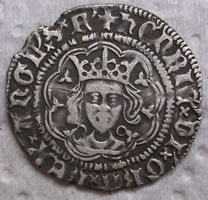 I
have added three new pages to the site. The first one is identifying
British coinage with 2 links to great sites that show in some detail
how you start to ID hammered silver coinage by
I
have added three new pages to the site. The first one is identifying
British coinage with 2 links to great sites that show in some detail
how you start to ID hammered silver coinage by  The
other two new pages are
The
other two new pages are 

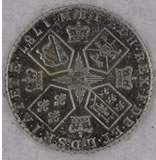



 I
got a letter from the Coroner explaining that a re-org of the department
has caused some delays in the treasure process to some of our finds.
However 3 treasure inquests are to be heard on the 28th March 2007,
Iconic gold ring, Medieval Madonna and child hat badge and a 17thC silver
button. I also got updates on the current position on all the other
treasures and uploaded to the
I
got a letter from the Coroner explaining that a re-org of the department
has caused some delays in the treasure process to some of our finds.
However 3 treasure inquests are to be heard on the 28th March 2007,
Iconic gold ring, Medieval Madonna and child hat badge and a 17thC silver
button. I also got updates on the current position on all the other
treasures and uploaded to the 

 The
Celtic Coin Index is the National on line data base that records all
Celtic gold, silver and bronze coins found in Britain. It has over 32,000
coins on record and you can view all these coins by CCI number, tribe,
graphical region etc. Each coin is unique and no two are exactly the
same. After the metal had been heated in the mould it would have to
be flattened before striking. The temperature at which this could be
achieved would be influenced by the composition of the alloy. The flattened
blank or flan would then be placed on a concave obverse die - to keep
the blank in place - and struck with the convex reverse die, as the
diagram shows. The dies tended to be much bigger than the area of the
flan, so that often only a part of the design shows on the resulting
coin. This is why there are so many individual nuances to each coin
made even from the same die they are unique. Here is an example of two
45BC Addedomaros coins from one of the hoards we found.
The
Celtic Coin Index is the National on line data base that records all
Celtic gold, silver and bronze coins found in Britain. It has over 32,000
coins on record and you can view all these coins by CCI number, tribe,
graphical region etc. Each coin is unique and no two are exactly the
same. After the metal had been heated in the mould it would have to
be flattened before striking. The temperature at which this could be
achieved would be influenced by the composition of the alloy. The flattened
blank or flan would then be placed on a concave obverse die - to keep
the blank in place - and struck with the convex reverse die, as the
diagram shows. The dies tended to be much bigger than the area of the
flan, so that often only a part of the design shows on the resulting
coin. This is why there are so many individual nuances to each coin
made even from the same die they are unique. Here is an example of two
45BC Addedomaros coins from one of the hoards we found.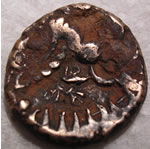





 Myself
an Billericay Mark managed to get out for a a few hours detecting yesterday
on a site which was heavily used by the Royal Artillery Regiment around
the 1790's. We have only had this land since last Jan but it has produced
a huge number of the early artillery buttons and as we found again yesterday,
lots of muskets balls. Interesting to note that we found French Napoleonic
caliber balls so were they testing the enemies weapons here ? I found
an amazing complete artefact on the edge of the field only an inch or
two down in the soil.
Myself
an Billericay Mark managed to get out for a a few hours detecting yesterday
on a site which was heavily used by the Royal Artillery Regiment around
the 1790's. We have only had this land since last Jan but it has produced
a huge number of the early artillery buttons and as we found again yesterday,
lots of muskets balls. Interesting to note that we found French Napoleonic
caliber balls so were they testing the enemies weapons here ? I found
an amazing complete artefact on the edge of the field only an inch or
two down in the soil. 
 This
is a 19thC barrel tap, spigot and key. Normally we only find parts and
fragment of this device but this has escaped the plough. Earlier versions
of this tap have a cockerel shaped key. However the find of the morning
was this very early hammered silver short cross penny found by Billericay
Mark , I took a photo of before and after to show the magic of the 'foil'
cleaning method we all use which does not damage the coin and highlights
the high points.
This
is a 19thC barrel tap, spigot and key. Normally we only find parts and
fragment of this device but this has escaped the plough. Earlier versions
of this tap have a cockerel shaped key. However the find of the morning
was this very early hammered silver short cross penny found by Billericay
Mark , I took a photo of before and after to show the magic of the 'foil'
cleaning method we all use which does not damage the coin and highlights
the high points. 



 It
is almost a year since the Sussex Field Archaeology unit completed the
survey and report on our huge Bronze age village site with spectacular
results, available to view on line
It
is almost a year since the Sussex Field Archaeology unit completed the
survey and report on our huge Bronze age village site with spectacular
results, available to view on line  We
are now moving to the next stage and purchasing a state of the art dual
channel GPR unit and the company kindly intends to sponsor us with a
30% discount which is a great result. I have been in contact with the
local Field Archeology unit so that the data we gather can be made available
to them for record. There are strict laws and guidelines to be followed
so no archaeology uncovered by this mapping can be excavated unless
by a professional of the Institute of Field Archeologists. The guideline
document
We
are now moving to the next stage and purchasing a state of the art dual
channel GPR unit and the company kindly intends to sponsor us with a
30% discount which is a great result. I have been in contact with the
local Field Archeology unit so that the data we gather can be made available
to them for record. There are strict laws and guidelines to be followed
so no archaeology uncovered by this mapping can be excavated unless
by a professional of the Institute of Field Archeologists. The guideline
document I
just recieved feedback from the museum on the recent silver bodkin needle
find I reported and it is indeed 17thC. It will now go through the treasure
process. Treasure is any artefact over 300 years old that has a 10%
gold or silver content by weight. If you make any find like the recent
plated Viking strap end and are unsure as to its gold or silver content
then report it to your local FLO or museum and it will be sent onto
the British museum for further tests. In the case of the strap end their
tests showed it was not 10% by weight and it was returned to the finder.
I
just recieved feedback from the museum on the recent silver bodkin needle
find I reported and it is indeed 17thC. It will now go through the treasure
process. Treasure is any artefact over 300 years old that has a 10%
gold or silver content by weight. If you make any find like the recent
plated Viking strap end and are unsure as to its gold or silver content
then report it to your local FLO or museum and it will be sent onto
the British museum for further tests. In the case of the strap end their
tests showed it was not 10% by weight and it was returned to the finder.






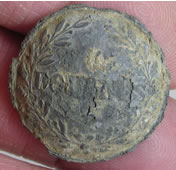 More
great results on repairing our hammered silver finds with before and
after pictures. The King John is especially tricky to straighten as
these are very fragile due to their age . Last week myself and Billericay
Mark got out for a few hours detecting on another new field where the
prisoners of war worked the land. It produced a ton of flat Georgian
and 4 holers type buttons, coppers, musket balls etc plus some great
Military buttons, 3 Prussian Army , 2 Navy and this early French button.
The guys on the French forum ID'd it as DOUANES = Customs. It is a solid
shank pewter type and probably dates in the 1800's. It still needs more
research,
More
great results on repairing our hammered silver finds with before and
after pictures. The King John is especially tricky to straighten as
these are very fragile due to their age . Last week myself and Billericay
Mark got out for a few hours detecting on another new field where the
prisoners of war worked the land. It produced a ton of flat Georgian
and 4 holers type buttons, coppers, musket balls etc plus some great
Military buttons, 3 Prussian Army , 2 Navy and this early French button.
The guys on the French forum ID'd it as DOUANES = Customs. It is a solid
shank pewter type and probably dates in the 1800's. It still needs more
research,












 Senior
member Chicago Ron is running the new Barn house accommodation from
Essex farm holidays that has Jacuzzi and Sauna built in on the 19th
to 26th March. A couple of Senior members have had to pull out at the
last minute due to a hospital visit so those slots are now free. If
you want a last minute hunt and stay in the master bedroom with on suite
facilities then drop me a mail. The house is only 2 miles from all the
sites. We have 2 brand new sites + all the existing 100 + fields for
the 2nd half of the season so you if you fancy helping us hot spot them
then come along. The team has their own MPV transport so you can come
and go as you like and detect as many or as few hours as you wish. Perfect
location for non detecting partners.
Senior
member Chicago Ron is running the new Barn house accommodation from
Essex farm holidays that has Jacuzzi and Sauna built in on the 19th
to 26th March. A couple of Senior members have had to pull out at the
last minute due to a hospital visit so those slots are now free. If
you want a last minute hunt and stay in the master bedroom with on suite
facilities then drop me a mail. The house is only 2 miles from all the
sites. We have 2 brand new sites + all the existing 100 + fields for
the 2nd half of the season so you if you fancy helping us hot spot them
then come along. The team has their own MPV transport so you can come
and go as you like and detect as many or as few hours as you wish. Perfect
location for non detecting partners.




 A
military button I found last week is interesting as it appears to be
a 111th Regiment of foot but there was not a 111th. The legend is partial,
Kings ____ Royal Bucks and the makers match gives
A
military button I found last week is interesting as it appears to be
a 111th Regiment of foot but there was not a 111th. The legend is partial,
Kings ____ Royal Bucks and the makers match gives 
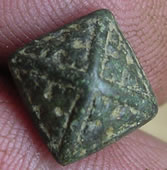















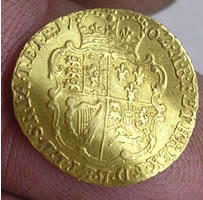


 I
am busy finishing up the last of the export paperwork before the first
of the die hard winter hunts starts on the 10th Feb with just 3 guys
on 150 fields !!! They are an old returning experienced crew, Boston
Bud, NJ Ed and Arz Al who have all made some serious finds here in the
past. Bud holds the honour of finding the only Saxon gold coin and also
a American 1 dollar gold Indian head here, no pressure then LOL.
I
am busy finishing up the last of the export paperwork before the first
of the die hard winter hunts starts on the 10th Feb with just 3 guys
on 150 fields !!! They are an old returning experienced crew, Boston
Bud, NJ Ed and Arz Al who have all made some serious finds here in the
past. Bud holds the honour of finding the only Saxon gold coin and also
a American 1 dollar gold Indian head here, no pressure then LOL. I
have started a new page with some history of the 17thC English civil
war battles around Colchester and combined it with a few of our musket
ball and cronade finds.
I
have started a new page with some history of the 17thC English civil
war battles around Colchester and combined it with a few of our musket
ball and cronade finds. 


 It
has been a remarkably good year for Jettons from the 1400's and I have
posted a load more unpublished ones to the
It
has been a remarkably good year for Jettons from the 1400's and I have
posted a load more unpublished ones to the 
 I
have split the find page
I
have split the find page 



 Weights
coin
Weights
coin Updates
to the dress buttons pages, now sorted by time frame
Updates
to the dress buttons pages, now sorted by time frame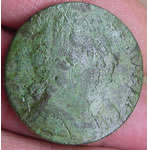








 Vegas
Mike had a pouch full of buttons including another early Royal Navy
1748 Hexagonal Rose type and this historic regiment button of the 29th
Regiment of foot. Posted here
Vegas
Mike had a pouch full of buttons including another early Royal Navy
1748 Hexagonal Rose type and this historic regiment button of the 29th
Regiment of foot. Posted here 


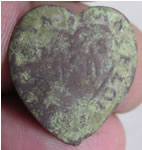




 Up
loaded some real neat buttons and do dads to the bottom of
Up
loaded some real neat buttons and do dads to the bottom of 



 I
have uploaded a load more unpublished finds onto the bottom of
I
have uploaded a load more unpublished finds onto the bottom of 
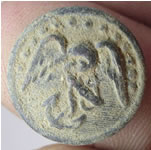





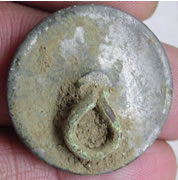





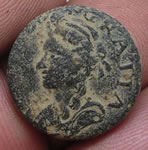
 Great
find , 14th/15thC 1/2 Gold Ryal - King with sword and shield standing
in a ship type with rose coin weight 7.42g.
Great
find , 14th/15thC 1/2 Gold Ryal - King with sword and shield standing
in a ship type with rose coin weight 7.42g. 


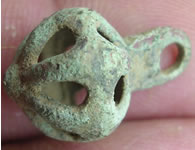


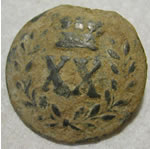






 Yesterday
a reader sent me an e-mail and attached his on - line book on Navy buttons
that he has written. I had spent huge numbers of hours unsuccessfully
searching the web trying to find this type of information and it pops
into my inbox. It has coloured pictures identifying nearly all the buttons
on our Navy page. Tim the author has written 17 more books on Tunic
buttons of all types and is going to send me a copy of each. If anyone
wants a copy then contact him direct and he will send you them electronically
for a small charge. The book even managed to ID the earliest Navy button
we had found which was incorrectly listed on my dress button page. It
is interesting to note that some of the other earliest Navy buttons
are of a Tudor Rose design.
Yesterday
a reader sent me an e-mail and attached his on - line book on Navy buttons
that he has written. I had spent huge numbers of hours unsuccessfully
searching the web trying to find this type of information and it pops
into my inbox. It has coloured pictures identifying nearly all the buttons
on our Navy page. Tim the author has written 17 more books on Tunic
buttons of all types and is going to send me a copy of each. If anyone
wants a copy then contact him direct and he will send you them electronically
for a small charge. The book even managed to ID the earliest Navy button
we had found which was incorrectly listed on my dress button page. It
is interesting to note that some of the other earliest Navy buttons
are of a Tudor Rose design. 





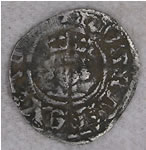


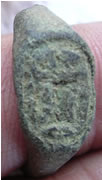
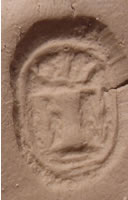





 With
the new year over with the exporting procedure is back to full flight
again. Another load of great finds were lurking in the export pouches
and I particularly liked this 19thC Napoleon and child gilded statue.
It came off the same site where the Napoleonic prisoners of war were
working but I am not sure if it is French or English so I have sent
it off to the French forum for their input on what it signifies. During
the break they also managed to ID a load of our outstanding buttons
With
the new year over with the exporting procedure is back to full flight
again. Another load of great finds were lurking in the export pouches
and I particularly liked this 19thC Napoleon and child gilded statue.
It came off the same site where the Napoleonic prisoners of war were
working but I am not sure if it is French or English so I have sent
it off to the French forum for their input on what it signifies. During
the break they also managed to ID a load of our outstanding buttons



 This
site was obviously used heavily for POW's from 3 wars, Napoleonic, WWI
and WWII.
This
site was obviously used heavily for POW's from 3 wars, Napoleonic, WWI
and WWII.





 'Militaines
Ineiamiers'
'Militaines
Ineiamiers'


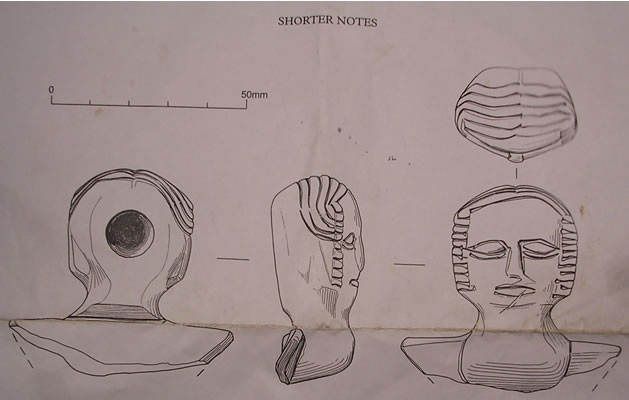

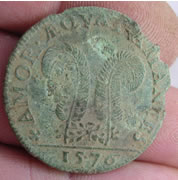









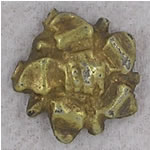



















 Base
metal coin with some history
Base
metal coin with some history  17thC
Tokens with history on farthings
17thC
Tokens with history on farthings

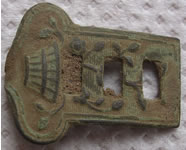



 This
is a very busy time paperwork wise preparing export license applications.
Every single metal object is looked at again very closely and more detailed
research is under taken on the 'unknowns'. Although it is very time
consuming this is a very important exercise as there are always finds
overlooked while the hunts are in progress. Each guy gets a MS Word
document e-mailed to then with a detailed finds list and full coloured
photo's of all finds made. This document forms part of the export application.
This
is a very busy time paperwork wise preparing export license applications.
Every single metal object is looked at again very closely and more detailed
research is under taken on the 'unknowns'. Although it is very time
consuming this is a very important exercise as there are always finds
overlooked while the hunts are in progress. Each guy gets a MS Word
document e-mailed to then with a detailed finds list and full coloured
photo's of all finds made. This document forms part of the export application.



















